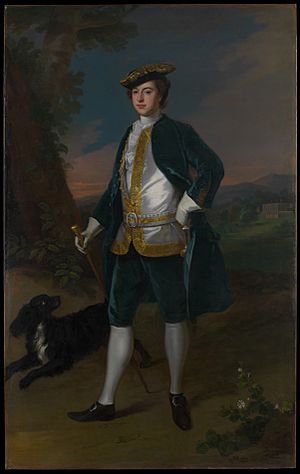James Dashwood facts for kids
Quick facts for kids
Sir James Dashwood
Bt
|
|
|---|---|

Sir James Dashwood, 1737 portrait by Enoch Seeman the Younger, from 1737 but with Dashwood's house in the background
|
|
| Born | 1715 |
| Died | 1779 |
Sir James Dashwood, 2nd Baronet (1715 – 1779) was an English politician. He was a member of the House of Commons, which is like a parliament, from 1740 to 1768.
Contents
Early Life of Sir James Dashwood
Sir James Dashwood was born in 1715. His father was Robert Dashwood. He inherited his special title, "Baronet," from his grandfather, Sir Robert Dashwood, 1st Baronet. His mother was Dorothy Reade.
James went to school at John Roysse's Free School in Abingdon. This school is now known as Abingdon School. He was also a leader for the Old Abingdonians Club in 1746. This club is for former students of the school.
Inheriting Estates and Grand Tour
When Sir James was 19, in 1734, he inherited many large areas of land in Oxfordshire. At that time, he was on a "Grand Tour." This was a long trip around Europe that young, wealthy people often took to learn about art and culture.
Kirtlington Park: Sir James's Grand Home
After inheriting his lands, Sir James decided to build a very impressive house. This house was called Kirtlington Park.
Building Kirtlington Park
The construction of Kirtlington Park took place between 1742 and 1746. The main builders were William Smith and John Sanderson. The first plans for the house were drawn by James Gibbs. The beautiful gardens around the house were designed by a famous landscape architect named Lancelot Brown.
Sir James also collected many books for a large library in his new home. He even hired a sculptor and interior decorator, James Lovell, to work on the house in 1747.
The Famous Dining Room
One special part of Kirtlington Park was its dining room. It was decorated in a fancy style called "rococo." In 1931, this entire dining room was moved! You can now see it at the Metropolitan Museum of Art in New York City. Artists like Thomas Roberts and either Henry Cheere or John Cheere helped create its beautiful details.
Lancelot Brown worked on the gardens of Kirtlington Park from 1751 to 1757. During this time, an older house on the property was taken down in 1750. Brown also changed some of the earlier garden designs.
Sir James's Political Beliefs
In local politics, Sir James Dashwood supported what was known as the "old interest." In national politics, he was a Jacobite. This meant he supported the idea of bringing back the old royal family to the throne. He also worked to help people who faced unfair rules because of their religion.
Political Groups and Meetings
Sir James belonged to a group called the Loyal Brotherhood. This was a social club for politicians who shared similar views. They met in London to plan their political actions. During the 1745 Jacobite Rebellion, Sir James and other local politicians chose not to join the county's defense group.
In 1749, a survey described Sir James as a strong Jacobite. His local political group held meetings where they supported the idea of the "Young Pretender," who was a leader of the Jacobite cause. These meetings continued into the 1750s.
Tory politicians, like Sir James, often held informal meetings that felt more like social gatherings. For example, a dinner was held at Sir James's house in 1756 to discuss voting rights. The University of Oxford gave him an honorary degree. The city also made him their High Steward, which was an important local position.
Sir James in Parliament
In 1738, Sir James Dashwood held the position of High Sheriff of Oxfordshire. This was a senior role in the county.
Becoming a Member of Parliament
In 1740, he became a Member of Parliament (MP) for Oxfordshire. He was elected without anyone running against him. He was elected again in 1741.
Sir James quickly became known for speaking his mind. In 1753, he spoke out against a law that would have made it easier for Jewish people to become British citizens. He also spoke against another law that affected people living in British colonies.
The Challenging Election of 1754
The election of 1754 was very confusing in Oxfordshire. Sir James faced strong opposition from other politicians. In the end, four people were elected for a constituency that usually only had two MPs. After legal arguments, Sir James and his fellow politician, Viscount Wenman, lost their seats. This happened even though they had advice from famous lawyers.
Return to Parliament and Retirement
In 1761, a deal was made between the different political groups. Sir James was able to return to Parliament once more, again without opposition. He wasn't a very active MP, but he was very interested in laws about land ownership. He decided to retire from politics in 1768.
Sir James's Family Life
Sir James Dashwood married Elizabeth Spencer on February 17, 1739. Elizabeth was the daughter of Edward Spencer. Sir James and Elizabeth had six children: three sons and three daughters.
Their oldest son, Henry Watkin, inherited his father's special title, the baronetcy.
Here are some of their other children:
- Their oldest daughter, Elizabeth, married George Montagu, 4th Duke of Manchester.
- Their daughter Anne married John Stewart, 7th Earl of Galloway in 1764. They had 16 children together!
- Their third daughter, Catherine, married Lucy Knightley, who was also an MP.
- Their second son was Thomas. He traveled to India and married Charlotte Auriol. Thomas's son, also named Thomas John, worked for the government in India. In 1822, he married Susan Wodehouse.
See also
- List of Old Abingdonians

